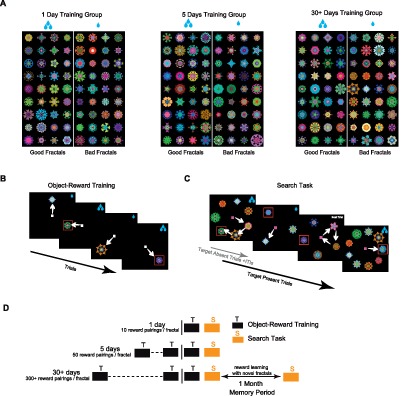Figure 1.

Training and testing procedures. (A) Fractal objects for monkey R (n = 216), each of which was consistently associated with a large reward (Good objects) or a small reward (Bad objects). (B) Object-reward training: A large or small reward was delivered after the monkey made a saccade to a fractal object. The fractal was presented in one of eight directions peripherally (15°). (C) Search task (test): A large or small reward was delivered after the monkey chose one among multiple fractals. The choice was determined by gaze longer than 400 ms so that the monkey was allowed to make multiple saccades with shorter gaze durations. Monkey could return to center to go to the next trial if no Good fractal was found. The number of simultaneously presented fractals varied across trials (15° eccentricity, display size = 3, 5, 7, 9). Among them, only one fractal was Good object in half of the trials. In the other half, no Good object was present (not shown). In (B) and (C), red square indicates Good object (not shown to the monkey). (D) Each monkey viewed three separate groups of reward-biased fractals (Figure 1A) with different training amounts (1, 5, or 30+ days; 72 fractals/group) followed on the last day (vertical line) by the search task (Figure 1C). Fractals in the “30+ days” group were tested again after 1 month (Mem, in subsequent Figures). During this time monkeys never saw the 30+ day fractals but were engaged in object-reward training with a new set of fractals. Monkeys also saw 72 fractals with choice trials during training and another 72 fractals in perceptual group (Figure 7) not shown in (A).
